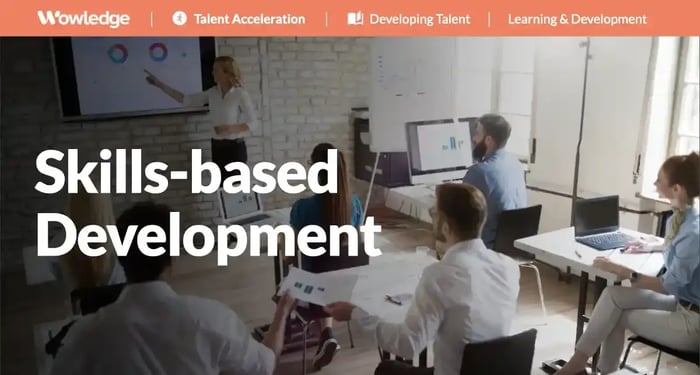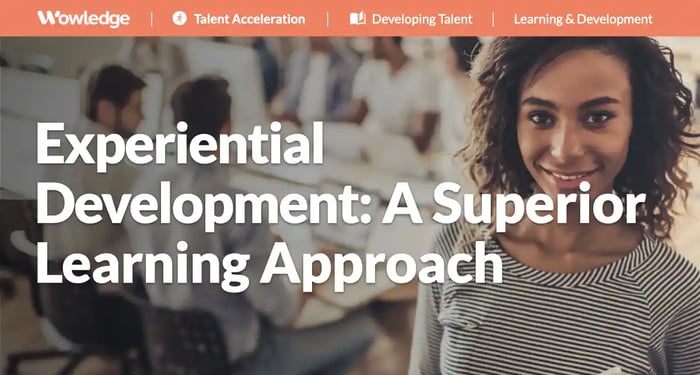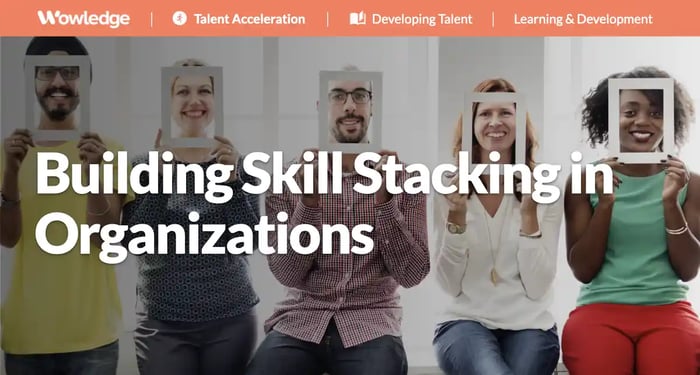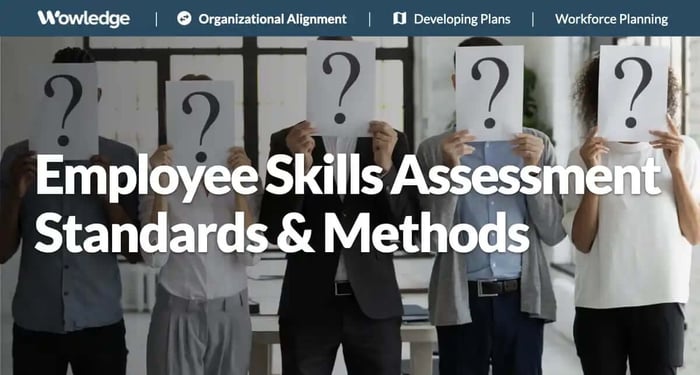Table of Contents
- The talent shortage is a long-term trend
- Skills-based talent management offers some relief
- The importance of continuous learning and development
- 1. Identify the current and emerging skills and gaps
- 2. Categorize roles by their strategic criticality
- 3. Evaluate current supply
- 4. Replace degree requirements with skills-based development and certifications
- 5. Research available programs for developing needed capabilities
- 6. Promote the existence and availability of such programs for internal development
- Relevant Practices & Tools
- FAQs
Despite recent reductions in force, global talent shortages have been well documented and discussed over the past 5+ years, with alarm bells ringing across all industries and sectors. The issues start with lowered birth rates and continue with falling graduation rates, restricted levels of immigration, drops in college enrollments, and record levels of turnover. The near- and mid-term picture looks dire for many industries, especially retail, hospitality, food service, and healthcare. The question is, can skills-based development be part of the solution?
This situation is begging for strategies that companies can use to ease the impact on their ongoing operations. Waiting for a shift in workforce availability is not an option. Organizations need to act today to ease the strain on talent acquisition teams and hiring managers, and skills-based development provides a key part of the solution.
The talent shortage is a long-term trend
The fact of the matter is that the baby boomers and GenXers, who dominated the labor market for years, are retiring, and their Millennial and Gen Z kids (and grandkids) just don’t represent enough volume to replace them. Think about the calls for social security and Medicare cuts that are based on relative population size challenges—there just aren’t enough workers (and employers) paying into the system to maintain those at current benefit levels.
On top of that, even with robust national hiring news, native-born Americans' employment levels have only increased by 0.3 percent this year versus February 2020 (while interestingly, foreign-born workers' employment has shot up by 9.3 percent). Interestingly, the US Department of Labor reports that in 2022, the foreign-born accounted for 18.1 percent of the U.S. civilian labor force, with a majority in blue-collar or service roles.
But the bigger and more painful issue points to challenges in higher-growth jobs that have historically required college degrees. Dropping enrollments, skyrocketing tuition and heavy student loan debt are driving prospective students to question the value of a college degree. Where 14 of the 20 fastest-growing occupations arguably requiring some level of post-high school education and training, the lowered preference for such schooling is troublesome. Research is helping us understand what (and why) this is happening:
- College student levels dropped by 2.5 million between 2012 and 2022. While the trend may have been influenced by the COVID pandemic and lower birth rates, it is raising alarm bells regarding near-term talent availability. Even before the pandemic, the nation was facing a shortage of more than nine million college-educated workers over the next decade, and more than 800,000 workers with an associate degree or some college according to research conducted by the American Action Forum.
- The Hechinger Report takes us further by reporting that the proportion of high school graduates enrolling in college in the fall after they finish high school has dropped from a high of 70 percent in 2016 to 63 percent in 2020, the most recent year for which the figure is available, according to the National Center for Education Statistics.
- From 2010 to 2020, annual enrollment at postsecondary institutions fell 14% nationally, according to the National Center for Education Statistics. Their numbers suggest that there are four million fewer students compared to 10 years ago.
- A recent article in Bloomberg reports that 39 million Americans drop out of college without finishing their degree.
- Finally, Forbes reports that 16.7 percent of workers ages 21 or older have student loan debt, and over one-half of all college students have student loans that average $29,000 per student.
The trends are unmistakable, and while changes that might impact labor markets such as economic conditions (e.g., rampant inflation or industry downturns), global socio-political upheavals (e.g., in developed nations), or significant changes to immigration policies might increase labor availability, companies need to adapt and adjust their talent strategies to ensure access to sufficient worker resources.

Skills-based talent management offers some relief
Organizations across the commercial and governmental spectrum are rapidly embracing a new approach to assessing and hiring that can support a broadening of the available talent pools. In the most basic terms, the emergence of the skill-based organization (SBO) or talent management practices is bringing non-degreed candidates into consideration for many roles. This is designed to help ensure that genuinely qualified candidates get hired by virtue of their acquired skills as opposed to the historical use of a college degree as a proxy for certain skills. This is important because it opens the door for the non-degreed worker with the requisite skills to perform the role without closing it to college graduates with the same skills.
Viewed as a pathway to better “democratizing” hiring, major employers who have dropped degree requirements for many roles and are leading the skill-based charge in the job market include:
- IBM
- Accenture
- Dell
- Bank of America
- Delta Airlines
- Tesla
- Apple
- General Motors
- Costco
- CVS
- Hilton
- Home Depot
- Lowe’s
- Netflix
- Nordstrom
- State Street
While editing job requirements to eliminate college degree requirements might be seen as an entry point to adopting such practices, it is not as simple an approach as it might appear. In another Wowledge post "It’s All About Skills-based HR", we lay out some success criteria and guidance for implementing such an approach.
But as the adoption of such a program appears to be crucial for increasing the pool of available talent for open roles, it is equally important to consider how such approaches can be leveraged to enhance the ongoing skills-based development of employees, whose skills are increasingly at risk due to rapid advances in professional or technical expertise, technology adoption, work processes, and so on. The creation and adoption of programs, processes, and practices that support the continuous development of strategically targeted employee skills is the essential step in managing talent requirements in the current and near future.

The importance of continuous learning and development
We are in the midst of dramatic changes to jobs, with skills requirements rapidly evolving due to technology adoption (digital platforms and apps, robotics, e-commerce and digital trade, and artificial intelligence). Changes in task and workflow methods are leading to estimates that the lifespan of skills is five years at best. The World Economic Forum estimated in 2016 that 35% of workers’ skills would be disrupted in the following five years; by 2023, that share rose to 44%. That means that re-skilling and upskilling must become a continuous endeavor by employees and the companies that employ them. And skills-based development is the essential element of such an approach.
The good news is that this is a widespread and historical preference of workers for continued development and growth, so the motivation on their part is there. The bad news is that the above study reports that while talent shortages dominate, existing training is not filling the gaps; 63% of workers in the US say they’ve participated in job-related training in the past 12 months, yet a lack of development and resulting mobility continue to be reported as key drivers and reasons for turnover. Maybe the training they are participating in is dominated by required administrative or compliance training?
The issue is that the days of employers relying on a catalog of traditional classroom and eLearning courses on an LMS and expecting them to self-select the right ones are long passed. Newer learning experience (LX) technologies, driven by AI and machine learning can suggest formal courses and informal learning opportunities that link an employee’s strengths, experiences, and skills to other roles. But there exists an entire world of programmatic possibilities that tie those suggestions to a given organization’s longer-term strategic directions and targeted skill deficits. With or without technology, HR teams must help proactively drive employee skills-based development towards the company’s strategic needs in volumes that will meet its business requirements over time. We’re simply not addressing the need for upskilling fast enough.
And relying on tuition reimbursement is not sufficient. Its availability is not as widespread as many might imagine—only 47% of employers pay for undergraduate or graduate school expenses to their employees as of 2019 (Statista). While U.S. corporations spend nearly $180 billion annually on formal training and talent development, less than 16% of that is spent on tuition reimbursement (The Georgetown University Center on Education and the Workforce). The time commitment involved in pursuing a degree is a roadblock to many employees, especially those with families at home.
The challenge, therefore, becomes one of identifying the skills needed in the near future, locating resources for their development at scale, matching the appropriate employees (and candidates) to each of those, and making more aggressive moves to provide (and promote the availability of) the skills-based development that employees need.
The key steps to understanding what skills-based development is required and how:
1. Identify the current and emerging skills and gaps
Use strategic workforce planning as a platform for identifying key business strategies, trends, and advances that will impact future staffing requirements. Perform assessments of near-term and future changes coming to key functions and departments that will likely impact the roles of the employees in those units. Consider planned product and/or service offerings, changes in markets addressed/served, and technology adoption (e.g., process automation, robotics, AI/machine learning capabilities) and assess the effect on the roles. Once evaluated, identify the skill, knowledge, and ability requirements that employees will have to acquire to operate effectively and productively when the new capabilities are deployed. Add to those the currently required skills that are in short supply among current employees in each function.
2. Categorize roles by their strategic criticality
Conduct a critical workforce segmentation exercise to classify the roles that are most crucial to the meeting of long-term company strategies. With this, limited resources can be focused on the roles that have the greatest impact on company objectives.
3. Evaluate current supply
Create and conduct employee skill assessments against a skills inventory or catalog. This can be accomplished by developing or acquiring (and customizing) a skills database and having employees self-rate themselves on the relevant skills and level of competency for each. Then have their managers review and validate each one during the annual performance cycle. The aggregated results can then be assessed against current and future business needs.
4. Replace degree requirements with skills-based development and certifications
Open the aperture on how to define qualified candidates by assessing jobs for skills gaps, and assess the extent to which a college degree is or is not needed. Wherever possible remove college degree requirements in job descriptions with skills and any associated credentials. While some positions, such as those in engineering, public accounting, medicine, education, legal, etc. will continue to require bachelors or advanced degrees, associated and support positions below them may not. For other roles, evaluate how the skills needed for those can be acquired through non-degree coursework, job experience, certificate programs, or a combination of those.
5. Research available programs for developing needed capabilities
Once the required skills and gaps are articulated, searches should be conducted for existing programming that addresses those. A wide variety of credible programs exist that are based on accepted professional standards and bodies of knowledge for a range of positions and professions, from IT to sales, analytics to supply chain. Such certification programs offer the advantage of including education, application, and skill validation through testing and ongoing recertification education. With well-established and accepted subject matter and skills development and testing capabilities, corporations can feel secure in leveraging those for employee development.
As professional certifications range from those appropriate for entry-level employees up to highly experienced and formally educated professionals, they therefore are highly relevant for career entry, mobility, and upskilling applications. They offer several advantages over traditional in-house programming, including:
- They keep people engaged for a longer period of time than a traditional series of eLearning courses, given the length of time required to complete and earn them.
- They involve verifiable skill acquisition based on the common use of post-course/module testing.
- They create capabilities in multiple skills that are often put to use on the job and observed gradually as the employee completes multiple modules or courses that make up the certification program.
Such training and certifications are provided by professional associations, universities, and private providers alike—both live and online offerings exist for many of these. Coursework and testing costs can range from hundreds to several thousands of dollars but are much less expensive and time-consuming than degree programs. That said, it is worthwhile to check with tax experts to see if any of the available programs are provided by organizations that are designated as an “Eligible Educational Institution” and thus qualify for corporate tax deductions.
Examples of the range of certification programs include those from the following governing bodies and providers:
- Information Technology: CompTIA A+, Cisco, Microsoft, Amazon Web Services (AWS), IBM Linux Professional Institute (LTI), Apple, Oracle, and Workday, among others.
- Sales: American Association of Inside Sales Professionals (AA-ISP), The National Association of Sales Professionals (NASP), Sales and Marketing Executives International, HubSpot Academy, National Retail Federation, Challenger, etc.
- Analytics: AWS, DataCamp, CareerFoundry, Microsoft, Cloudera, IBM, Google, and a host of colleges and universities.
- Supply Chain: Association for Supply Chain Management (ASCM)/APICS, Institute for Supply Management (ISM), National Contract Management Association (NCMA), International Society of Logistics (SOLE).
- Project Management: Project Management Institute (PMI), AgilePM Foundation, Scrum Alliance, Scaled Agile, Inc, American Society for Quality (ASQ), The International Association for Six Sigma Certification (IASSC), etc.
- Human Resources: Society for Human Resource Management (SHRM), Human Resources Certification Institute (HRCI), International Foundation of Employee Benefit Plans (IFEBP), Association for Talent Development (ATD), WorldatWork, etc.
- Finance: American Institute of Certified Public Accountants (AICPA), National Association of State Boards of Accountancy (NASBA), Financial Industry Regulatory Authority (FINRA), CFA Institute, Financial Management Association, Institute of Business & Finance (IBF), etc.
- Medical/Healthcare: American Institute of Health Care Professionals (AIHCP), American Hospital Association Certification Center (AHA-CC), American Academy of Professional Coders (AAPC), National Association for Healthcare Quality (NAHQ), Healthcare Compliance Association (HCCA), American Heart Association, etc.
- Digital Marketing: Google, Meta, Kellogg/Northwestern University, Online Marketing Certified Professionals (OMCP), Digital Marketing Institute (DMI), American Marketing Association (AMA), Duke University, Columbia Business School, etc.
6. Promote the existence and availability of such programs for internal development
Proactively and widely communicate the certification and development programs to the employee base, especially the populations (and their managers) who have the prerequisite and relevant skills and capabilities needed to further adopt the enhanced skill sets and succeed in the new and/or expanded roles. Consider updating career pathways based on the overlap of skills used in a job family(s) or role(s) with the new ones targeted in the certification or development program. Create new or update existing positions that leverage the accumulated skills and have those leveled and fit into the company's job structure or architecture.
Alert managers in those targeted functions or departments and encourage them to identify suitable employees whose skills and career interests align with the certification and potential for moving into the new/updated roles. Reinforce (and reward) managers’ behavior by tracking the enrollments of their employees in targeted programs, employee reactions via surveys on their awareness and interest in the offerings, and any mobility into the targeted roles or functions that require the new skillsets.
Both external and internal candidate pools can be expanded by specifying the skills needed to perform a job and then replacing outdated college degree requirements with specific requirements and certifications. And by bringing more robust professional development programs and certifications into the mix of existing learning offerings, accelerated skill growth and employee growth and associated engagement and retention can be achieved.
Relevant Practices & Tools
Advanced Learning and Development Practices to Accelerate Skill and Capability Growth. >
These practices focus on developing, staffing, and managing a learning and development function that is highly responsive to business needs and leverages both technologies and... more »
Deploying Technology to Enhance Learning Delivery and Management Efficacies. >
Creating, managing, delivering, and curating learning content at scale typically requires technology solution(s)... more »
Creating Informal Learning and Experiential Development Opportunities for Cost-effective Delivery. >
Informal learning is broadly defined as any learning activity that is not learned in a formal class, has no set goals or objectives, and focuses on the enhancement... more »
Creating a Learning Culture that Supports Career-long Education and Development. >
A learning culture is one that encourages and supports employees’ continuous pursuit of knowledge, sharing of learning with others, and motivation to continuously upgrade... more »
The Persona Template: Define Different Types of Learners, their Preferences, and Requirements for Learning and Development. >
The Persona Template Tool documents the specific types of learners for whom a learning or development program or content is designed... more »
FAQs
What does a “skills-based” approach look like beyond removing degree requirements?
It bases hiring decisions and the development and advancement of employees on their acquired skills, rather than on the historical use of a college degree as a proxy for overly broad, poorly defined skill sets. It replaces the content in job postings and career paths with those built upon measurable skills and proof of ability. Hiring screens shift towards demonstrable capabilities measured by work samples, practical tests, and validated certifications. Inside the company, roles are grouped by skill families, with clear ways to earn, show, and be paid for new skills. Governance focuses on keeping the skill lists current and tied to real work.
How can a company build a usable skills inventory without a year-long taxonomy project?
Free, open-source skills databases and ontologies such as Open Skills Network (OSN), Lightcast’s Skills Taxonomy, and skills-ml are available, but can take time to explore, leverage, and implement. Otherwise, start with three to five priority roles and list the ten to fifteen skills that drive performance in each, using a combination of industry benchmarks and recent top performers as the model. Map those skills to observable proof points, such as completed project documentation, trusted-source certification test scores, or quantitative performance metrics. Translate the list into simple, but well-defined levels (e.g., basic, capable, advanced) that managers can verify during interviews, presentations, and talent reviews. Expand to more roles only after the first set is in use.
Which metrics show whether skills-based development is working within 6–12 months?
Track time to fill for targeted roles, the share of hires without degrees who meet performance standards, and internal move rates into critical or labor market shortage roles. Measure completion of priority learning paths and the percentage that convert into role changes or pay steps. Watch early-tenure retention and first-90-day productivity for reskilled staff. Report these alongside program costs to show ROI.
What risks should be managed when shifting to a skills model?
Common pitfalls include inflated self-ratings, acceptance of low-quality credentials, vendor overreliance and lock-in, dated training and certification content by providers, and skill decay after training. Mitigate these by requiring job-based proof, ongoing vetting and revalidation of providers, keeping content accessible, and scheduling refresh checks for fast-changing skills. Protect data privacy when storing skill profiles and ensure assessments are accessible. Involve legal early where licenses or regulated titles apply.










